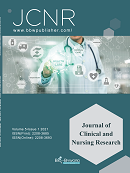Abstract
Objective: To analyze the effect of protection motivation theory on the quality of life of patients with spinal fracture. Methods: From August 2019 to September 2020, 72 patients with spinal fracture were selected and randomly divided into two groups. The routine nursing group was the routine nursing group, and the combined nursing with the theory of protective motivation was the dynamic nursing group. Results: The hospitalization time, detumescence time, healing time and muscle strength recovery time of group A were shorter than those of group B (P < 0.05). The VAS score and Barthel index score of the dynamic group were better than those of the conventional group (P < 0.05); The score of SF-36 in the group A was higher than that in the group B (P < 0.05). Conclusions: The application of protection motivation theory in the nursing of patients with spinal fracture can shorten the healing time of fracture, promote the recovery of muscle strength, relieve the pain of fracture, and then improve the ability of daily life and quality of life of patients.
References
Li R, Chen J, 2020, Application of Protective Motivation Theory in Nursing Care of Spinal Fracture. Laboratory Medicine and Clinical, 17 (4): 540-542
Gao Y, Liu H, 2019, Application Effect of Nursing Intervention Based on Protection Motivation Theory in Nursing Care of Patients with Spinal Fracture and Influence of Barthel Index. China Disability Medicine, 27 (16): 26-28.
Tian Y, Zhang J, Xu Y, et al., 2017, Application Progress of Patient Care Based on the Theory of Protective Motivation. Acta Nursing, 2017, 22 (24,329): 28-32.
Tian Y, 2018, Application Progress of Protection Motivation Theory in Health Behavior Promotion and Disease Management. Nursing Research, 32 (24): 3845-3847.
Wu D, 2020, Privacy Concerns and Influencing Factors of Medical Data in the Context of Big Data: An Empirical Study Based on the Theory of Protection Motivation. Journal of Henan Normal University: Philosophy and Social Sciences, 2020(5): 23-29.
